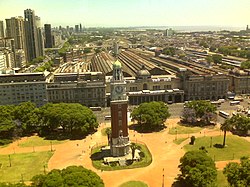Plaza Fuerza Aérea Argentina
Plaza Fuerza Aérea Argentina | |
|---|---|
| City square | |
 Plaza Fuerza Aérea Argentina, with the Torre Monumental in the center and the Retiro railway station in the background. | |
| Features | Torre Monumental Surrounded by the Retiro railway station on Avenida Dr. José María Ramos Mejía, Avenida San Martín and Avenida del Libertador. |
| Location | Retiro Buenos Aires, Argentina |
| Location of Fuerza Aérea Argentina in Buenos Aires | |
| Coordinates: 34°35′32″S 58°22′25″W / 34.59222°S 58.37361°W | |

Plaza Fuerza Aérea Argentina (
barrio (district) of Retiro in Buenos Aires, Argentina. The square is located between the Retiro railway station on Avenida Dr. José María Ramos Mejía, Avenida San Martín and Avenida del Libertador. It was designed and built in the 1940s and inaugurated on January 4, 1945.[1] Originally called Plaza Británica ("British Square"), its name was changed in 1982 to the current one, by paying homage to the Argentine Air Force after the Falklands War, which was its first war against an external enemy. However, some still refer to it by its old name and also Plaza de los Ingleses ("English Square"), although the latter name was never used officially. The Torre Monumental (formerly "Torre de los Ingleses"), is located in the center of the square.[2]

References
- ^ "Se renovó la Plaza Fuerza Aérea ubicada en Retiro" (in Spanish). Palermomio.com.ar. 2017-01-17.
- ^ Germán Wille (2 April 2022). "La Guerra de Malvinas, en las calles de Buenos Aires: las plazas y pasajes que cambiaron de nombre en medio del conflicto". La Nación (in Spanish).
Wikimedia Commons has media related to Plaza Fuerza Aérea Argentina.

